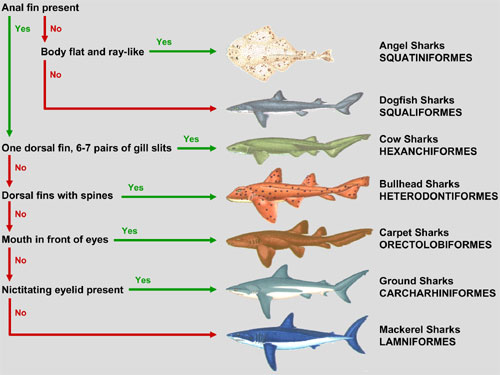Guide to Shark Identification
Identifying free-swimming sharks in the wild isn’t easy. It requires knowledge, experience, and a willingness to look for details. Unfortunately, underwater lighting is subdued and a cruising shark will rarely remain long in any one place, thus reducing visible contrast and the time available to gather clues useful for identification. Fresh-caught sharks are often distorted by their weight in air and their colors usually fade quickly. Often, field identifications must be made on the basis of an overall gestalt. Therefore, with the exception of a few ‘easy marks’, all identifications of free-swimming sharks should be considered tentative.
Below are a sequence of flow-charts, species descriptions, and illustrations designed to help you identify the 40 species of sharks most commonly encountered by boaters, anglers, and divers. In both the flow charts and species descriptions, identifying characters are limited to easily observable, external features.
To make an identification, begin with the flow chart entitled “Key to Selected Shark Orders”. Start at the top and proceed downward, choosing YES or NO as best describes the shark you saw. Once you have determined the major group to which your shark belongs, click on the order indicated or the representative diagram. You will be directed to a page providing a summary of characteristics shared by all members of that order and either another flow-chart designed to help you narrow down your shark to family or one or more species profiles. Most family descriptions include a list of characteristics and — unless you are quite sure that ‘your’ shark belongs to a certain family — it is strongly recommended that you check the animal you saw against these features before proceeding to the individual species profiles. Each species profile consist of a full-color illustration, a list of key identifying features, a note on that species average and maximum size, a list of habitat types it is known to inhabit, and a list of zoogeographic regions encompassing the known range of that species (Habitat and Distribution use the same categories and definitions as throughout the Ecology section of this website).
It is hoped that, by being able to confidently identify most of the sharks you are likely to encounter, your appreciation and enjoyment of the experience will be enhanced. Once you have a provisional identification of the shark you saw, you can test it against a more detailed identification guide (see the Guide Books) or read more about that species on this website.
Pleasant shark watching.
ID Guides to:
Squatiniformes |
Squaliformes |
Hexanchiformes |
Heterodontiformes
Orectolobiformes |
Carcharhiniformes|
Lamniformes

